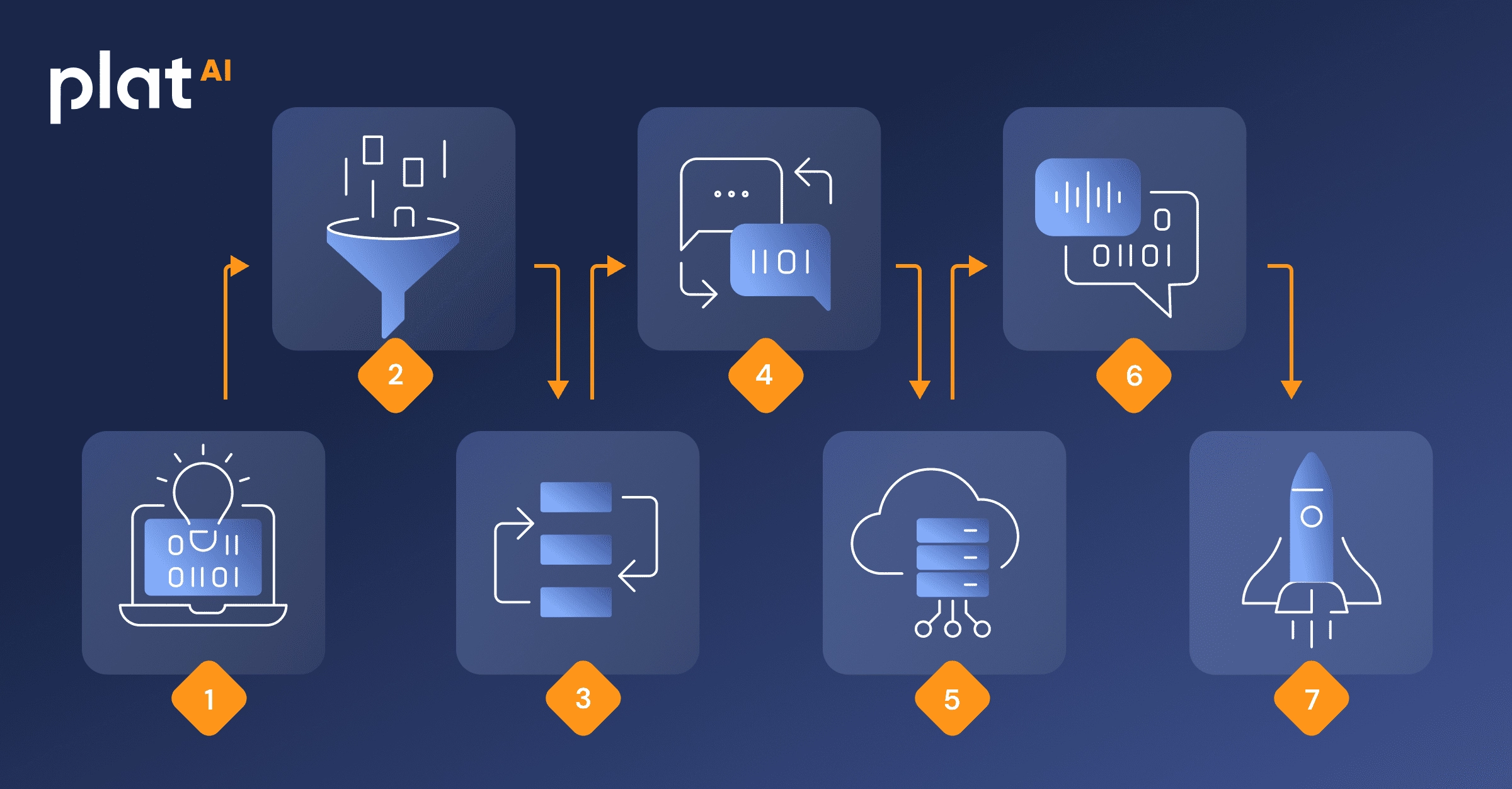How to Build an AI: A Comprehensive Beginner’s Guide to Artificial Intelligence
Since the advent of the digital age in the 1940s, when the first computers were invented, humanity has been on a never-ending quest to replicate and enhance human intelligence through machines. This effort has moved us into an era where artificial intelligence (AI) isn’t just a futuristic theoretical concept but a practical tool that shapes our everyday lives. From automating routine tasks to solving complex problems, AI has become integral to various industries and personal projects.

Interested in creating your own AI? Whether you’re a student eager to learn about technology, a hobbyist looking to experiment, or an aspiring developer aiming to build sophisticated AI systems, this article is your gateway. Here, you’ll gain the insights you need to embark on your AI journey, covering everything from the practical applications of AI to the foundational steps required to build one from scratch.
By the end of this guide, not only will you understand the significance of AI in today’s digital landscape, but you will also be equipped with the knowledge to start creating your own intelligent systems. Let’s explore how you can transform your curiosity into creation, step by step.
Understanding the Basics of AI
AI is a subfield of computer science that aims to develop systems that can perform tasks that typically require human intelligence. These include learning, reasoning, problem-solving, perception, and language understanding.
At the heart of AI are machine learning and deep learning. Machine learning uses algorithms to parse data, learn from it, and make informed decisions based on what it has learned. Deep learning, a subset of machine learning, uses structures called neural networks that mimic the human brain’s operations.
The latest AI advancements, like OpenAI’s GPT series and Google’s BERT, have significantly pushed the boundaries in natural language processing, enhancing how machines understand human language.
Beyond language, AI’s capabilities are also impacting various sectors, particularly healthcare. AI-driven tools are transforming patient care through more accurate diagnostics, personalized medicine, and robotic surgeries.
We can also see the impact of AI in public transportation through the use of self-driven vehicles and drones.
In creative industries, artists are harnessing AI to compose music, create artwork, and even write scripts.
Beyond typical voice assistants like Siri and Alexa, AI also plays a significant role in powering a variety of smart home devices, improving home automation and security through the Internet of Things (IoT).
Increasingly, building AI systems is becoming less complex and cheaper. The principle behind making a good AI is collecting relevant data to train the AI model. AI models are programs or algorithms that enable the AI to recognize specific patterns in large datasets.
The better you make AI technology, the more wisely it can analyze vast amounts of data to learn how to perform a particular task.
The process of analyzing data and performing tasks is called machine learning (ML). For example, Natural language processing (NLP) gives machines the ability to read, understand human languages, and mimic that behavior. The most promising AI apps rely on ML and deep learning. The latter operates based on neural networks built similarly to those in the human brain.
Real-world applications of AI systems are wide-ranging. Below, you can find the most common examples of AI in daily life:
- Speech Recognition
Also known as automatic speech recognition (ASR), computer speech recognition, or speech-to-text, is a capability that uses NLP to process human speech into a written format. For example, Siri utilizes speech recognition to conduct voice searches.
- Customer Service
Increasingly, more companies are turning to online virtual agents for customer service, thus replacing human agents. According to Servion Global Solutions, 95% of all customer interactions will involve artificial intelligence by 2025.
- Computer Vision
In this case, AI technology allows computers and systems to derive meaningful information from digital images, videos, and other visual inputs. You can see its application in photo tagging on social media.
- Discovery of Data Trends
AI algorithms can use consumers’ behavior to discover data trends, allowing companies to build effective cross-selling strategies. As a result, companies can offer relevant add-on recommendations during the checkout process. That’s where predictive analytics software steps in.
Such software allows real-time decision-making with your data. For instance, the software can generate risk assessment models, such as fraud and risk detection, targeted advertising, and product recommendations.
- Fraud Prevention
One of the primary problems that artificial intelligence tackles is payment and sensitive information fraud. Companies utilize AI-based systems to detect and prevent this type of fraud effectively.
- Automated Stock Trading
AI-based high-frequency trading platforms make thousands or, sometimes, millions of trades each day. As of 2020, half of stock market trades in America were automated. According to Allied Market Research, the global algorithmic market size is forecast to account for $31.2 million by 2028.
Different Types of AI
Before building your AI, make sure you understand the three types of AI:
- Artificial Narrow Intelligence (ANI): We encounter this type every day. ANI excels in handling specific tasks, such as driving a car using autonomous driving technologies or managing your schedule like Apple’s Siri. ANI is often referred to as “Weak AI.” However, despite its label, there’s nothing weak about its capabilities within its specialized domain. It performs with remarkable precision and efficiency.
- Artificial General Intelligence (AGI): A step beyond ANI, AGI represents a hypothetical AI with human-like cognitive abilities. This type of AI can learn, understand, and apply intelligence across a broad spectrum of tasks, matching the intellectual capabilities of humans. While AGI is still in the developmental stages, it is seen as a potential bridge to more advanced forms of AI. Enthusiasts even suggest that glimpses of AGI capabilities might be observed in advanced systems like OpenAI’s GPT-4, sparking exciting discussions in technology circles.
- Artificial Superintelligence (ASI): ASI is the pinnacle of AI research. In this envisioned future, AI surpasses human intelligence in all aspects, from creativity and social skills to problem-solving and scientific innovation. This level of AI is expected to pioneer new discoveries and innovations at an unprecedented pace.
How to Build Your Own AI System in 7 Simple Steps
Gartner forecasts significant growth in the AI market, with a compound annual growth rate (CAGR) of 36.6% from 2024 to 2030. This growth reflects continuous innovation and increased adoption of advanced technologies across various industries. This surge highlights AI’s growing importance in enhancing operational efficiencies and creating new market opportunities for businesses globally.
So, how to build an AI? Let’s go through the basic steps to help you understand how to create an AI from scratch.

Step 1: Identify the Problem You Want to Solve With AI – Define Your Objective
Start by defining your goals. Ask yourself, “What specific problem will AI solve?” For example, you could be cutting patient wait times with an AI scheduling system in healthcare. While defining your goal, set measurable targets, such as cutting the patient wait times by 20% or 30%. Clear metrics help guide the development process and measure the AI system’s success.
To identify the problem effectively, ensure you investigate and understand the current challenges in the system by analyzing patient flow data and peak times to identify the problem effectively. Keep records of your findings to communicate the objective and strategy to all stakeholders.
Step 2: Collect And Prepare the Data
Now, when you’ve framed the problem, you need to pick the right data sources. It’s more critical to get high-quality data than to spend time on improving the AI model itself. Data falls under two categories:
- Structured Data
Structured data is clearly defined information that includes patterns and easily searchable parameters. For example, names, addresses, birth dates, and phone numbers.
- Unstructured Data
Unstructured data doesn’t have patterns, consistency, or uniformity. It includes audio, images, infographics, and emails.
Next, you need to clean the data, process it, and store the cleaned data before you can use it to train the AI model. Data cleaning or cleansing is about fixing errors and omissions to improve data quality
Step 3: Choose a Programming Language
There is more than one programming language, including the classic C++, Java, Python, and R. The latter two coding languages are more popular because they offer a robust set of tools such as extensive ML libraries. Make the right choice by considering your goals and needs. For example:
- Python is a good choice for beginners as it has the simplest syntax that a non-programmer can easily learn.
- C++ boasts a high level of performance and efficiency, making it ideal for AI in games.
- Java is easy to debug, user-friendly, and can be used on most platforms. In addition, it works well with search engine algorithms and for large-scale projects. As a rule, Java is used to build desktop applications.
- R is developed for predictive analysis and statistics. Thus, it’s primarily used in data science.
Step 4: Opt for the Right Platform
Apart from the data required to train your AI model, you need to pick the right platform for your needs. You can go for an in-house or cloud framework. What’s the main difference between these frameworks? The cloud makes it easy for enterprises to experiment and grow as projects go into production and demand increases by allowing faster training and deployment of ML models.
- In-house Frameworks
For example, you can choose Scikit, Tensorflow, and Pytorch. These are the most popular ones for developing models internally.
- Cloud Frameworks
With an ML-as-a-service platform or ML in the cloud, you can train and deploy your models faster. You can use IDEs, Jupyter Notebooks, and other graphical user interfaces to build and deploy your models.
Step 5: Create And Select an Algorithm
When telling the computer what to do, you also need to choose how it will do it. That’s where computer algorithms step in. Algorithms are mathematical instructions. It’s necessary to create prediction or classification machine learning algorithms so the AI model can learn from the dataset.
There are several types of algorithms for different kinds of tasks. You could use a combination of each depending on the problem you want to solve:
- Predictive Algorithms: These are designed to predict future results based on historical data. For example, to reduce patient wait times, a predictive algorithm could analyze past appointment durations and predict future demand.
- Classification Algorithms: These algorithms classify data into predefined groups. For example, in a healthcare setting, they could classify patients based on their risk of missing appointments, allowing the system to adjust schedules accordingly.
- Clustering Algorithms: These are used to group a set of objects so that objects in the same group are more similar to each other than those in other groups. This could be useful in segmenting patient types to optimize resource allocation.
- Decision Tree Algorithms: These algorithms use a set of rules to make decisions. For instance, they could decide the best scheduling strategy based on the type of appointment and the time of day.
- Neural Networks: Inspired by the human brain, these algorithms excel in handling complex patterns and large datasets, again, like those in healthcare systems, to improve decision-making and efficiency.
Step 6: Train the Algorithms
Moving forward with how to create an AI, you need to train the algorithm using the collected data. It would be best to optimize the algorithm to achieve an AI model with high accuracy during the training process. However, you may need additional data to improve the accuracy of your model.
Model accuracy is the critical step to take. Therefore, you need to establish model accuracy by setting a minimum acceptable threshold.
For example, a social networking company working on deleting fake accounts can set a “fraud score” between zero and one for each account. After some research, the team can decide to send all the accounts with a score above 0.9 to the fraud team.
Step 7: Deploy and Monitor
Finally, after you’ve developed a sustainable and self-sufficient solution, it’s time to deploy it. By monitoring your models after deployment, you can ensure it’ll keep performing well. Don’t forget to monitor the operation constantly.
Sum Up
“How to build an AI” is a question many are interested in these days. To make an AI, you need to identify the problem you’re trying to solve, collect the right data, create algorithms, train the AI model, choose the right platform, pick a programming language, and, finally, deploy and monitor the operation of your AI system.
Try our real-time predictive modeling engine and create your first custom model in five minutes – no coding necessary!
- Fully operational AI with automated model building and deployment
- Data preprocessing and analysis tools
- Custom modeling solutions
- Actionable analytics
- A personalized approach to real-time decision making
Table of Contents
- Understanding the Basics of AI
- Different Types of AI
- How to Build Your Own AI System in 7 Simple Steps
- Step 1: Identify the Problem You Want to Solve With AI – Define Your Objective
- Step 2: Collect And Prepare the Data
- Step 3: Choose a Programming Language
- Step 4: Opt for the Right Platform
- Step 5: Create And Select an Algorithm
- Step 6: Train the Algorithms
- Step 7: Deploy and Monitor
- Sum Up



